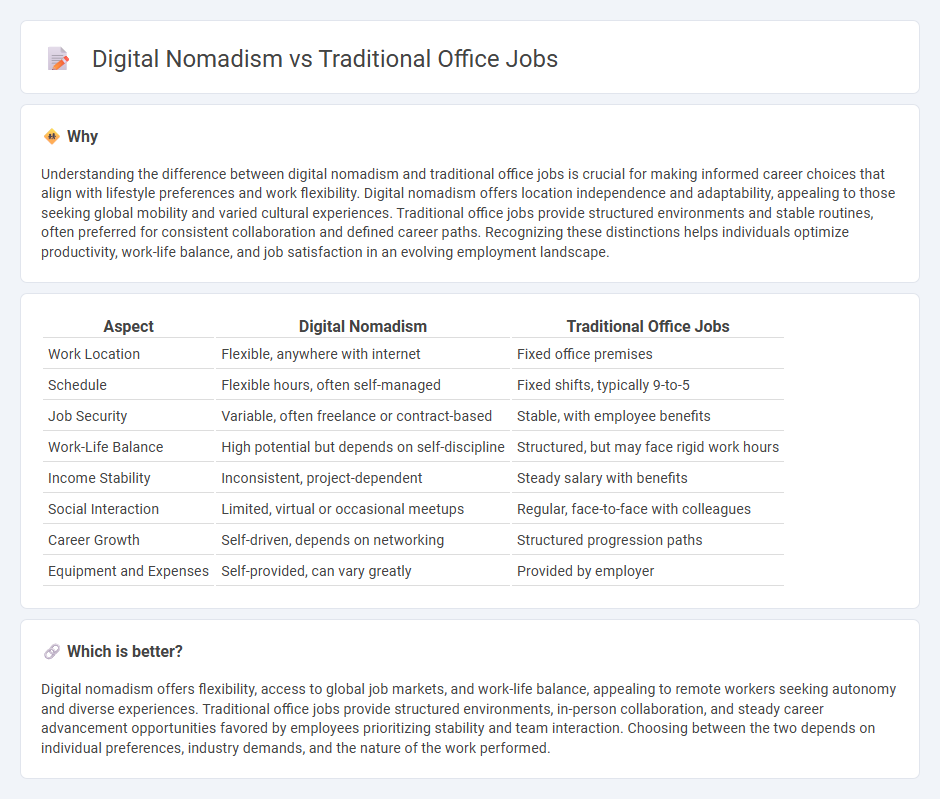
Employment landscapes evolve as digital nomadism offers location-independent work opportunities, contrasting with traditional office jobs anchored in fixed physical spaces. Remote work technologies enable digital nomads to leverage global connectivity, enhancing flexibility and work-life balance compared to conventional office environments. Explore how these employment models impact productivity, lifestyle, and career growth to understand which suits your professional goals.
Why it is important
Understanding the difference between digital nomadism and traditional office jobs is crucial for making informed career choices that align with lifestyle preferences and work flexibility. Digital nomadism offers location independence and adaptability, appealing to those seeking global mobility and varied cultural experiences. Traditional office jobs provide structured environments and stable routines, often preferred for consistent collaboration and defined career paths. Recognizing these distinctions helps individuals optimize productivity, work-life balance, and job satisfaction in an evolving employment landscape.
Comparison Table
| Aspect | Digital Nomadism | Traditional Office Jobs |
|---|---|---|
| Work Location | Flexible, anywhere with internet | Fixed office premises |
| Schedule | Flexible hours, often self-managed | Fixed shifts, typically 9-to-5 |
| Job Security | Variable, often freelance or contract-based | Stable, with employee benefits |
| Work-Life Balance | High potential but depends on self-discipline | Structured, but may face rigid work hours |
| Income Stability | Inconsistent, project-dependent | Steady salary with benefits |
| Social Interaction | Limited, virtual or occasional meetups | Regular, face-to-face with colleagues |
| Career Growth | Self-driven, depends on networking | Structured progression paths |
| Equipment and Expenses | Self-provided, can vary greatly | Provided by employer |
Which is better?
Digital nomadism offers flexibility, access to global job markets, and work-life balance, appealing to remote workers seeking autonomy and diverse experiences. Traditional office jobs provide structured environments, in-person collaboration, and steady career advancement opportunities favored by employees prioritizing stability and team interaction. Choosing between the two depends on individual preferences, industry demands, and the nature of the work performed.
Connection
Digital nomadism and traditional office jobs intersect through the evolving landscape of remote work technologies and flexible employment policies, enabling employees to balance location-independent lifestyles with structured organizational roles. Advances in cloud computing, communication platforms, and cybersecurity facilitate seamless collaboration between digital nomads and office-based teams, enhancing productivity and talent acquisition worldwide. This integration fosters a hybrid employment model, merging the benefits of autonomy with the stability and resources of conventional office environments.
Key Terms
Source and External Links
10 Most Popular Types of Office Jobs - Traditional office jobs commonly include roles such as executive assistant, account manager, office manager, accounts payable clerk, administrative assistant, and data entry clerk, each with specific administrative, managerial, or clerical duties essential to office operations.
11 Types of Office Jobs (With Salaries and Duties) - Key traditional office roles also encompass receptionist, mail clerk, and office manager, with responsibilities like greeting visitors, handling mail, and ensuring the smooth daily running of the office environment.
The Perfect Blend: Balancing Remote vs. Traditional Office - Traditional office work provides benefits such as fostering community and collaboration among coworkers and enabling easier supervision and immediate feedback from managers when working onsite.
 dowidth.com
dowidth.com